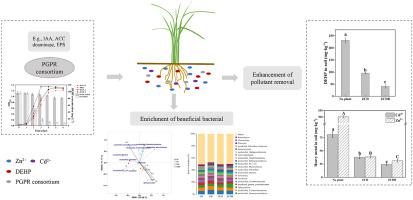Environmental Pollution ( IF 7.6 ) Pub Date : 2022-09-28 , DOI: 10.1016/j.envpol.2022.120303 Anran Liu , Wenjing Wang , Xiancao Chen , Xiaoyan Zheng , Wenting Fu , Gang Wang , Jing Ji , Chunfeng Guan

|
The coexistence of di (2-ethylhexyl) phthalate (DEHP), Cd, and Zn poses a serious challenge to soil ecosystems. This study aimed to evaluate the phytoremediation potential of rice assisted with a plant growth promoting rhizobacteria (PGPR) consortium for the remediation of DEHP, Cd, and Zn co-contaminated soil. The consortium consisted of four bacterial strains, all of which exhibited Cd–Zn resistance and DEHP degradability. The results showed that the rice assisted by the bacterial consortium dissipated 86.1% DEHP while removing 76.0% Cd2+ and 92.2% Zn2+ from soil within 30 d. The presence of the PGPR consortium promoted plant growth and improved soil enzymatic activity, which may have helped enhance the removal of DEHP and heavy metals from the soil. Moreover, the application of the consortium modified the bacterial community and increased the relative abundance of bacteria related to DEHP degradation (Sphingomonas, Xanthobacteraceae), heavy metal immobilization (Massilia), and soil nutrient cycling (Nitrospira, Vicinamibacterales), which promoted plant growth and the removal of DEHP and heavy metals from soil. Notably, the DEHP and heavy metal contents in rice decreased substantially during the phytoremediation process. Therefore, the PGPR consortium could be beneficial for enhancing the removal of DEHP and heavy metals from the soil, without inducing the accumulation of these pollutants in rice. In general, this study confirmed that the combined use of rice and the PGPR consortium could remedy DEHP and heavy metal co-contaminated soil economically and ecologically without simultaneously posing risks for rice consumption.
中文翻译:

PGPR 联合水稻对 DEHP 和重金属共污染土壤的植物修复:对根际土壤中离子稳态调节、光合作用改善和有益菌富集的见解
邻苯二甲酸二(2-乙基己基)酯(DEHP)、镉和锌的共存对土壤生态系统构成了严峻挑战。本研究旨在评估水稻在植物促进根际细菌 (PGPR) 联合体的辅助下修复 DEHP、Cd 和 Zn 共污染土壤的植物修复潜力。该联合体由四种细菌菌株组成,所有菌株均表现出对镉锌的抗性和 DEHP 降解性。结果表明,细菌联合体辅助的水稻消散了86.1%的DEHP,同时去除了76.0%的Cd 2+和92.2%的Zn 2+30 d 内从土壤中排出。PGPR 联合体的存在促进了植物生长并改善了土壤酶活性,这可能有助于增强 DEHP 和重金属从土壤中的去除。此外,该联合体的应用改变了细菌群落,增加了与 DEHP 降解(鞘氨醇单胞菌、黄杆菌科)、重金属固定化(Massilia)和土壤养分循环(Nitrospira )相关的细菌的相对丰度。, Vicinamibacterales),促进植物生长和去除土壤中的 DEHP 和重金属。值得注意的是,在植物修复过程中大米中的 DEHP 和重金属含量大幅下降。因此,PGPR 联合体可能有利于提高 DEHP 和重金属从土壤中的去除,而不会导致这些污染物在水稻中的积累。总的来说,本研究证实,大米和 PGPR 联合使用可以在经济和生态上修复 DEHP 和重金属共同污染的土壤,同时不会对大米消费构成风险。











































 京公网安备 11010802027423号
京公网安备 11010802027423号